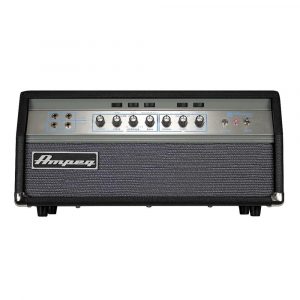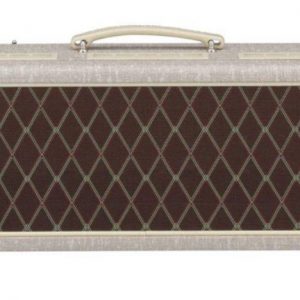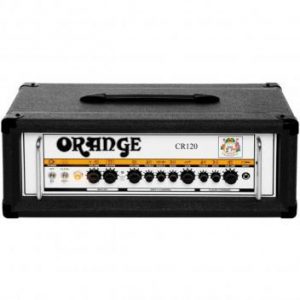Peavey Headliner 1000
$307.99
Get ready to rock the world with Peavey’s Headliner 1000 guitar amp head, delivering powerful and crystal-clear sound in a compact and reliable design!
Compare
Description
If you’re a guitarist looking for a powerful, reliable, and versatile amp head, then the Peavey Headliner 1000 is definitely worth your consideration. This dynamic amp head delivers a whopping 1000 watts of power, making it one of the most powerful guitar amps on the market. In this article, we’ll delve into the features that make the Peavey Headliner 1000 a worthy investment for musicians of all levels and genres.
One of the standout features of the Headliner 1000 is its impeccable tone. Regardless of the style of music you play, this amp head will deliver a clean, crisp sound with plenty of punch and depth. The EQ features a 7-band graphic system, which allows you to adjust the tone to your desired specifications. The two-channel preamp also comes with a bright switch, allowing you to add an extra bit of high-end sparkle to your sound.
The Headliner 1000 also has plenty of flexibility when it comes to connectivity options. It has an effects loop, which allows you to easily connect your favorite pedals and processors. It also can connect directly to a PA system for gigs where you don’t want to lug around heavy cabinets, thanks to the built-in DI.
Another great feature of the Peavey Headliner 1000 is its durability. The amp head is housed in a sturdy metal casing, which protects it from the rigours of life on the road. It also has cooling fans to prevent overheating, prolonging the lifespan of the components inside.
The Headliner 1000 is also incredibly easy to use, with a simple layout that makes it a great choice for beginners and experienced players alike. The large knobs make adjusting the settings a breeze, and the clear labeling ensures that you always know what you’re adjusting.
One potential downside of the Headliner 1000 is its weight. At 48 pounds, it can be a bit heavy to lug around to gigs. However, this is a trade-off for the amount of power and tone the amp head provides.
Overall, the Peavey Headliner 1000 is an excellent guitar amp head that delivers a powerful, versatile, and reliable performance. Whether you’re playing rock, metal, blues, or anything in between, this amp head is sure to provide the tonal foundation you need to elevate your playing to the next level. If you’ve been on the lookout for a high-quality amp head that will stay with you for years to come, the Headliner 1000 is definitely worth considering.
Peavey Headliner 1000 properties
| Product name |
Headliner 1000 |
| Brand |
Peavey |
| Type |
Bass Amplifier Heads, Guitar Amplifier Heads |
| Sound Effects |
Crunch, Looper |
| Sound Setting |
Equalizer, Volume |
| Features |
Tuner for Instrument |
| Connection Inputs |
Tele/TRS 6.3mm/1/4″ |
| Connection Outputs |
Headphones 6.3mm, Tele/TRS 6.3mm Single |
| Return/Send |
Tele/RTS 6,3mm |
| Power Output (RMS) |
1000.0 W |
| Amplifier Model |
Tube |
| Power Supply |
Electrical |
Frequently Asked Questions:
What are the recommended techniques for optimizing the tonal characteristics of a Peavey Headliner 1000 Guitar Amplifier Head when paired with specific types of speakers or microphones?
To optimize the tonal characteristics of a Peavey Headliner 1000 Guitar Amplifier Head when paired with specific types of speakers or microphones, there are several recommended techniques. Here are some guidelines:
1. Speaker Selection: When choosing speakers for your Headliner amplifier, consider the type and size of the venue where you will be performing. For smaller venues, a 12" speaker may suffice, while larger venues may require 15" or even 18" speakers. Also, make sure the speakers are designed to handle the power output of your Headliner amplifier. Microphone Placement: When using microphones with your Headliner amplifier, place them in a way that captures the sound you want. For example, for a clean, bright sound, position the microphone closer to the high-frequency driver of the speaker. For a warmer, fuller sound, position the microphone near the center of the speaker. EQ Settings: Use the equalization (EQ) controls on your Headliner amplifier to fine-tune the tone you want. Start with the factory settings and make small adjustments until you achieve the desired sound. Some general guidelines for EQ settings are:
- Bass: Increase for a full, warm sound or decrease for a tighter, more defined bass response. Midrange: Adjust to balance out the lows and highs in the tone. Increase for a thicker, warmer midrange or decrease for a brighter, more cutting midrange. Treble: Adjust to shape the upper frequencies. Increase for a brighter, more shimmery sound or decrease for a smoother, less harsh sound. Volume Levels: Make sure you are not overdriving the amplifier by keeping the volume levels at a reasonable level. Overdriving can result in distortion and loss of clarity in the tone. Feedback Control: Use the feedback control on your Headliner amplifier to minimize unwanted feedback from the speakers. Adjust the control until you achieve a clean, stable sound. By following these recommended techniques, you should be able to optimize the tonal characteristics of your Peavey Headliner 1000 Guitar Amplifier Head when paired with specific types of speakers or microphones. Remember to experiment and find what works best for your specific needs and preferences.
How does the proprietary dynamic EQ circuit in the Peavey Headliner 1000 amplifier head enhance tone and clarity at high volume levels?
At high volume levels, where unwanted frequencies can become muddy and indistinct, the proprietary dynamic EQ circuit in the Peavey Headliner 1000 amplifier head enhances tone and clarity by automatically adjusting the equalization of the sound to compensate for the effects of distance and room acoustics. This ensures that every note is clear and articulate, even in large venues with complex acoustic environments. The dynamic EQ circuitry also helps prevent feedback and unwanted resonance, making it an ideal choice for live performances and recording applications where pristine tone and clarity are essential.
How do I optimize the performance of my Peavey Headliner 1000 Guitar Amplifier Head for live gigs, while maintaining maximum sound quality and minimizing feedback?
Here are some tips for optimizing the performance of your Peavey Headliner 1000 Guitar Amplifier Head for live gigs and minimizing feedback:
1. Use high-quality speaker cabinets: The Peavey Headliner 1000 is a head-only amplifier, which means you'll need to pair it with compatible speaker cabinets. Make sure the speakers you choose are of good quality and designed for live performance use. Peavey offers a range of speaker cabinets that are specifically optimized for use with their Headliner amplifiers. Use appropriate mic techniques: If you're using the Headliner 1000 to amplify acoustic or semi-acoustic instruments, such as an acoustic guitar or mandolin, it's essential to use a high-quality microphone and proper mic placement techniques. This can help minimize feedback and maximize sound quality. Use the right effects: The Headliner 1000 comes loaded with a range of built-in effects, including reverb, delay, chorus, and more. When playing live gigs, it's essential to use these effects judiciously to avoid feedback issues. For example, you might want to use a chorus or flanger effect to add some depth to your sound, but be sure to set the effect parameters carefully to minimize feedback. Optimize your stage setup: When setting up onstage for live performances, it's essential to position your Headliner 1000 and speaker cabinets correctly to minimize feedback issues. For example, you might want to place the amplifier and speaker cabinets at an angle to the audience to help direct the sound away from the microphones that are picking up the audio feed. Use a noise gate: A noise gate is a type of effect that can help minimize background noise and feedback issues in live performance settings. The Headliner 1000 comes with a built-in noise gate, which you can use to quickly and easily eliminate unwanted background noise from your sound. Use the right input and output settings: When using the Headliner 1000 for live gigs, it's essential to set the input and output levels carefully to ensure maximum sound quality and minimize feedback issues. For example, you might want to use a DI box (direct injection) to connect your instrument directly to the amplifier, which can help eliminate any unwanted background noise or feedback issues that might arise from using a microphone. Practice good stage etiquette: Finally, it's essential to practice good stage etiquette when playing live gigs with the Headliner 1000. This includes things like speaking into the microphone only when necessary, avoiding sudden movements that might cause feedback issues, and being aware of your positioning onstage in relation to other musicians and equipment. By following these tips, you can help ensure maximum sound quality and minimize feedback issues during live performances.
How does the Peavey Headliner 1000's proprietary dynamic EQ system differ from traditional parametric equalization in terms of tonal flexibility and processing efficiency?
The Peavey Headliner 1000 amplifier stands out from traditional parametric equalization systems with its unique and innovative proprietary dynamic EQ technology. While both the dynamic EQ and parametric EQ serve to shape the tone and frequency response of an audio signal, they differ in their approach to tonal flexibility and processing efficiency. Parametric EQ, commonly found in many high-end audio equipment, is a flexible equalization system that allows for precise adjustment of multiple parameters such as frequency, bandwidth, and gain. This type of EQ provides a wide range of tonal options but can be more complex to use due to the number of controls required. On the other hand, Peavey's dynamic EQ technology in the Headliner 1000 amplifier offers a more streamlined approach with greater processing efficiency. This innovative system utilizes advanced algorithms and intelligent processing techniques to automatically adjust the EQ response based on the input signal's characteristics. Instead of requiring manual adjustments, this dynamic EQ system allows for seamless and natural tonal shaping without sacrificing processing power or speed. In terms of tonal flexibility, the Headliner 1000 amplifier's dynamic EQ offers a unique and versatile tone-shaping experience that goes beyond traditional parametric EQ systems. Its intelligent algorithms analyze the input signal and automatically adjust the EQ response to optimize its sound quality in real time. This results in a more natural and transparent tonal output, which can be further refined using the amplifier's other tonal controls, such as the compressor, limiter, and speaker contouring features. Overall, Peavey's proprietary dynamic EQ technology in the Headliner 1000 amplifier offers a more efficient and streamlined approach to equalization, providing greater tonal flexibility and processing efficiency than traditional parametric EQ systems. Its intelligent algorithms offer a more natural and transparent tone-shaping experience that can optimize sound quality in real time, making it an ideal choice for musicians and audio engineers who demand the best in performance and versatility from their equipment.





Reviews
There are no reviews yet.